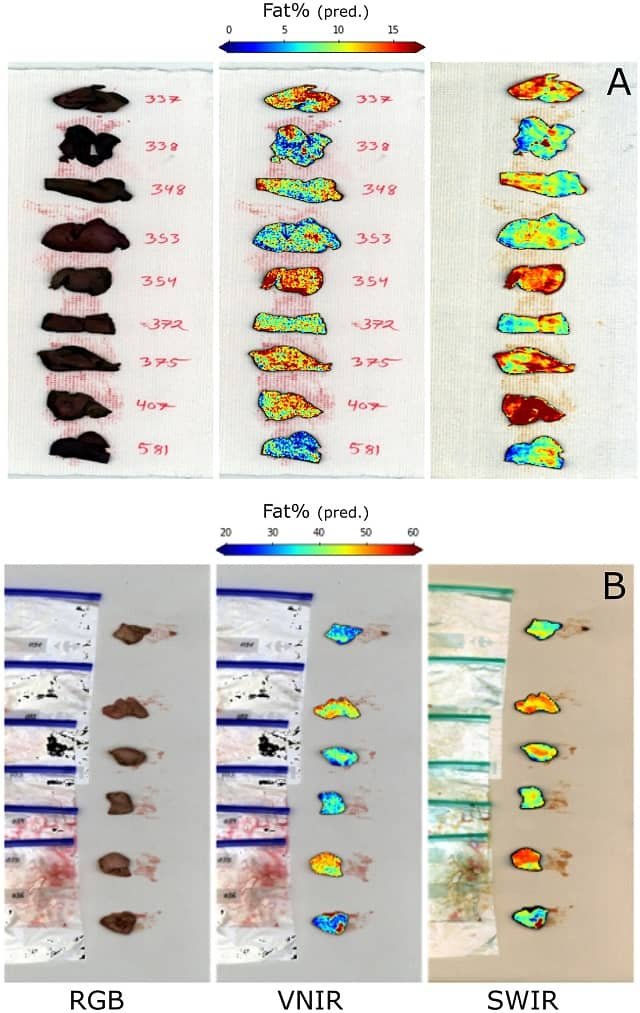
Lipid accumulation in the liver often compromises the health and robustness of farmed fish, leading to metabolic disorders, oxidative stress, and inflammation. Traditional methods for measuring liver fat content are slow and costly or subjective and prone to bias.
To address these challenges, researchers at NOFIMA introduced hyperspectral imaging, a cutting-edge technology that promises to revolutionize the assessment of liver fat in aquaculture species.
The challenge of liver fat in farmed fish
Lipids are essential in aquaculture diets, serving as a primary energy source for fish. However, excessive fat accumulation in the liver can negatively impact fish health.
Atlantic salmon (Salmo salar), European sea bass (Dicentrarchus labrax), and Atlantic cod (Gadus morhua), three commercially important species, exhibit different levels of liver fat accumulation.
For example, Atlantic salmon typically store lipids in muscle and viscera, with liver fat content ranging between 5% and 12%. In contrast, Atlantic cod stores more than 80% of its lipids in the liver, making liver fat a crucial factor in feed costs and commercial success. European sea bass also accumulates a significant amount of lipids in the liver, with fat content ranging from 18% to 60%.
“The current method for measuring liver fat in fish must be performed in a laboratory and is expensive. We save a lot by using hyperspectral cameras,” says Siri Storteig Horn, Breeding and Genetics Scientist at NOFIMA.
Traditional methods for measuring liver fat include chemical lipid extraction, which is accurate but labor-intensive, and visual scoring systems, which are quick but subjective. There is an urgent need for cost-effective, high-throughput methods to measure liver fat, especially for large-scale studies and selective breeding programs.
Hyperspectral imaging: A game-changer
Hyperspectral imaging (HSI) is a non-invasive, non-destructive technique that captures spatial and spectral information from samples. By analyzing how light interacts with tissue, HSI can infer chemical composition, including fat content. This technology has already proven useful in food quality assessment, parasite detection, and its potential in aquaculture is becoming evident.
In a recent study published in the journal Aquaculture, researchers evaluated the efficacy of HSI for estimating liver fat content in Atlantic salmon, European sea bass, and Atlantic cod.
Using two hyperspectral cameras covering the visible and near-infrared (VNIR) and short-wave infrared (SWIR) regions, the team developed Partial Least Squares Regression (PLSR) models to predict liver fat content.
Key findings
The study demonstrated that HSI can accurately predict liver fat content in the three species, with varying degrees of precision:
Atlantic Salmon
The SWIR spectral range provided the most accurate predictions, with an R² value of 0.89 and a Root Mean Square Error (RMSE) of 1.19%. The VNIR range also showed promising results but was less precise.
European Sea Bass
Both VNIR and SWIR ranges yielded comparable results, with R² values of 0.81 and 0.88, respectively. This suggests that HSI is particularly effective for sea bass, possibly due to a larger sample size and greater spectral variance.
Atlantic Cod
The SWIR range outperformed the VNIR range, but overall accuracy was lower compared to salmon and sea bass. This may be due to less variation in liver fat content among cod fed the same diet.
The study also highlighted the importance of selecting calibration samples that cover a wide range of fat content to improve model accuracy. For sea bass, selecting samples based on spectral variance (using Principal Component Analysis) enhanced predictive models.
Practical applications
The ability to quickly and accurately measure liver fat content using HSI has significant implications for aquaculture research and industry. This high-throughput method can facilitate large-scale studies on feed effects, fish health, and genetic research. Additionally, it opens the door to including liver fat as a selective trait in breeding programs, potentially improving the health and robustness of farmed fish.
“We can analyze feed composition and liver fat levels to ensure farmed fish receive what they need for their welfare and a quality end product,” explains Evan Durland, Reproduction and Genetics Scientist.
Future research could explore integrating VNIR and SWIR spectral data to improve prediction accuracy. Additionally, investigating the relationship between liver fat and other chemical components, such as proteins and carbohydrates, could further refine models. Applying HSI to quantify fatty acid content in fish liver also represents a promising avenue for future studies.
Conclusion
Hyperspectral imaging is set to transform how we evaluate liver fat in aquaculture species. By providing a fast, cost-effective, and accurate method for measuring liver fat, HSI can support more comprehensive research and enhance the health and productivity of farmed fish. As the aquaculture industry continues to grow, technologies like HSI will be essential for ensuring sustainable and efficient fish farming practices.
This research was supported by the NewTechAqua project, funded by the European Union’s Horizon 2020 program under grant agreement No. 862658, and by NOFIMA’s Strategic Project Deep Vision.
Contact
Samuel Ortega
Nofima (Norwegian Institute of Food, Fisheries and Aquaculture Research)
Tromsø, Norway
Email: samuel.ortega@nofima.no
Reference (open access)
Ortega, S., Lutfi, E., Horn, S. S., & Durland, E. (2025). Quantification of fat content in the liver of different aquaculture fish species using hyperspectral image analysis. Aquaculture, 597, 741924. https://doi.org/10.1016/j.aquaculture.2024.741924
Editor at the digital magazine AquaHoy. He holds a degree in Aquaculture Biology from the National University of Santa (UNS) and a Master’s degree in Science and Innovation Management from the Polytechnic University of Valencia, with postgraduate diplomas in Business Innovation and Innovation Management. He possesses extensive experience in the aquaculture and fisheries sector, having led the Fisheries Innovation Unit of the National Program for Innovation in Fisheries and Aquaculture (PNIPA). He has served as a senior consultant in technology watch, an innovation project formulator and advisor, and a lecturer at UNS. He is a member of the Peruvian College of Biologists and was recognized by the World Aquaculture Society (WAS) in 2016 for his contribution to aquaculture.
